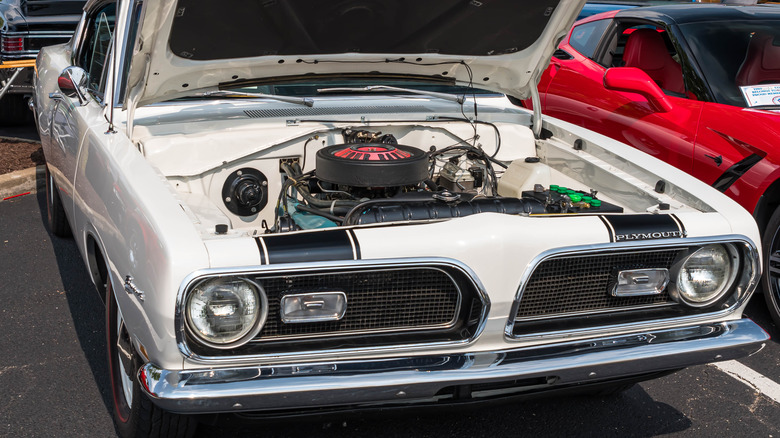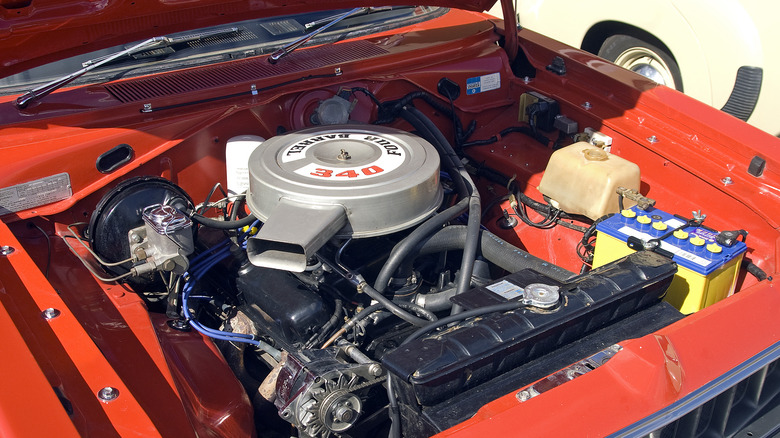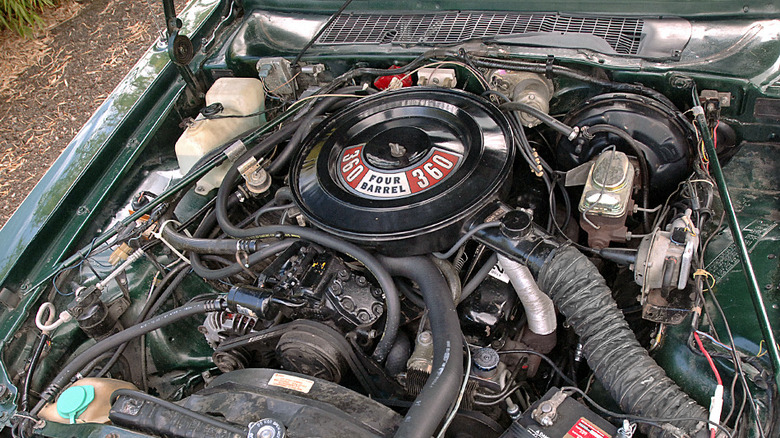Mopar 340 Vs. 360: Which Is The Better Engine?
In the history of engines made by Mopar — the parts division of Stellantis, who owns Chrysler, Dodge, Jeep, and more — the flashiest of the bunch naturally come from the height of the muscle car era in the 1960s and early 1970s. These Mopar engines were generally the company's B-series big block engines, which were often able to generate upwards of 400 horsepower, depending on the model.
While those numbers are eye-popping, Mopar made plenty of other V8 engines as well. Some Mopar engines were powerful enough to satisfy any number of people looking for some oomph under the hood, but didn't want the size and weight that came with a big block engine. Mopar also had the A-series small block engines as well, but even that may have been too heavy for some.
This is where Mopar's LA — or light A — engines came into play. These V8 engines began production in 1964, and had an incredibly healthy 40-year production span. LA engines were designed with the idea of maximizing the power of the A engines, but removing as much weight from them as possible. The LA line began with a 273 V8 and a 318 V8, but Mopar quickly introduced the Mopar 340 V8, which was followed up by the Mopar 360 V8 several years later.
Although only one digit separates the two engines in name, the two engines have quite a number of differences, and the 340 has certainly become the historical favorite. Does it deserve to be though?
What is a Mopar 340?
The Mopar 340 has its origins with the previous 318 V8 engine in the LA family. This was already a pretty good engine, but Mopar wanted to make a high performance version of it. To do this, the company took the 3.906 bore of the 318 and increased it to 4.04 inches, but the designers did not alter the stroke at all, allowing for a greater engine displacement. Mopar also understood that there would be a heavier burden placed on the engine due to its performance capabilities, so it replaced the cast iron crankshaft with a steel one.
The result was a rather impressive engine that could generate up to 275 horsepower and 340 pound-feet of torque — or at least that is what was advertised, as Hot Rod saw those numbers improve to 320 horsepower and 368 pound-feet of torque. These results made the engine quite a nice choice for street racers or anyone wanting a lightweight, powerful vehicle.
You would find the 340 V8 in several of the muscle and pony cars after its introduction in 1968, including the Dodge Charger and Plymouth Road Runner; and two years later, Mopar would put out a Six Pack version of the 340, which was exclusive to the Dodge Challenger and Plymouth Barracuda. As was the case with so many high performance V8 engines of the time, it became significantly hampered by the emissions regulations and oil embargo during the 1970s, seeing it phase out of production rather quickly. However, this has made it quite the product on the resale market that you will certainly be paying several thousand dollars to get.
What is a Mopar 360?
In 1971, Mopar released the 360 V8. This was not a case of taking the 340 and boring it out a little more. It actually had a slightly smaller bore than the previous engine at 4 inches even, but it had a longer 3.58-inch stroke. Another difference was that the 340 utilized a four-barrel carburetor, whereas the new 360 used a two-barrel initially. Two years into production, Mopar would add a four-barrel version for trucks. What the 360 did take from the 340 was its intake port heads, but used a smaller intake valve.
Just because this was a larger engine doesn't mean that it was geared for performance the same way. The first version of the 360 maxed out at 255 horsepower and 360 pound-feet of torque. Once the four-barrel version was put in heavier trucks compared to muscle cars, those numbers dropped to 200 horsepower and 290 pound-feet of torque.
While the 360 V8 also fell victim to the emissions restrictions of the 1970s, it was not hampered in the same way as the 340 because it wasn't as performance-focused. Consequently, it was able to greatly outlast the 340 and found its way into far more vehicles, including sedans like the Chrysler New Yorker and trucks like the Dodge Ram. The 360 remained in production all the way until the early 1990s.
The Mopar 340 may have the power and the scarcity, but the 360's longevity proves that it is not an engine to scoff at in any way.


